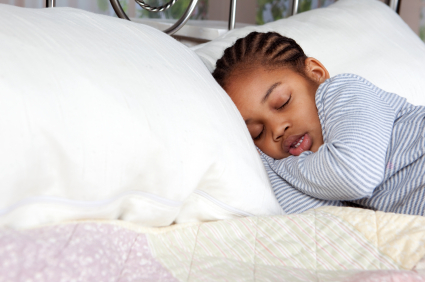
Some people think that preschoolers should be able to put themselves to bed, and maybe there are some four year olds, somewhere, who do. But 99% of kids five and under need a couple hours of calming downtime that includes dinner at home, and then a full-blown bedtime routine, with storytime and snuggling, in order to fall asleep easily at night.
After that, whether the parent can walk out of the room and let the child fall asleep on his own, or has to lie down with the child, will depend on three factors:
- Whether you got lucky and this child falls asleep easily by himself.
- Whether you have "taught" this child to put himself to sleep.
- Whether your child is relaxed, or is wired with a full backpack of pent-up stress and emotions from his day.
How to get your child to stay in bed?
1. Create safety.
It is completely normal for young children to have fears and worries. Sure, you know they're safe in bed, but they don't necessarily feel that way. They're little people in a big, scary world. If you're not there to keep them safe, they can easily feel frightened, alone in the dark.
The bedtime routine helps children feel safe because it is exactly the same each night, so they know what to expect -- and of course because it includes lots of soothing physical contact with you.
2. Regulate your own emotions.
It's natural to get frustrated when you just want your child to sleep, but yelling at him will make him feel less safe, and undermine your efforts to help him enjoy settling into his bed.
That's why it's important that we as parents prepare ourselves so that we stay in a good mood at bedtime, rather than losing it. You can expect children to resist the "forced separation" of bedtime. That's their job. It's our job to stay cheerful, patient and clear about the limit that yes, it is still bedtime.
3. Use play earlier in the evening to diminish anxiety.
Don't wait for bedtime. Earlier in the day, help your child work through those anxieties by roughhousing in a way that gets your child laughing for ten minutes. You can let him be a scary monster while you act frightened in a goofy way, or you can just get him laughing out his fears indirectly, by being a bucking bronco. Don't do this right before bed, or it will wind your child up. After dinner is a good time, followed by a bath and story to calm down.
4. If your child is afraid of "Monsters"
All kids build up an emotional backpack of small fears and upsets throughout their day. As they close their eyes at night, those feelings they've been fending off can swamp them and make them too anxious to settle into sleep.
So if your child expresses fear, listen and acknowledge. Don't ridicule, shame, or offer rational arguments; fears aren't rational and your child will stay frightened. What he needs is your support to feel safer. Say "I hear you're worried about monsters...That can be scary...Let's do something about that."
If your child is afraid of "Monsters" empower her by making some "Monster Spray" that she can spray around the room. All you need is lavender and water; some people add glitter, and glycerin will keep the glitter suspended in the bottle to make it more magical. Be sure to label the bottle so it looks powerful: "Do not use around monsters. Will make monsters disappear." Or just get a broom and sweep the monsters out of the closet together, and put them in the trash can, and take it out of your child's room.
These approaches work because they respond on the level of the fear, rather than just denying it. But be light about the whole process, rather
than grim. You want to communicate to your child that this is not an emergency, but rather a small challenge that you can support her to solve.
Talk to the monsters in a powerful way that puts them in their place: "Monsters aren't allowed in Samantha's bedroom....You monsters know better than this...Time to go now!"
5. Teach relaxation techniques.
Just as some adults have a harder time getting to sleep at night, so do some children. Help your child learn to relax into sleep. For some kids, music helps. Others like to listen to a guided meditation that teaches them to breathe deeply. You can also teach your child to inhale deeply and then exhale slowly and fully, which downshifts the body's alert systems.
One very effective technique is to touch each part of your child's body in turn, saying good night to it. Have your child take a deep breath in and as they breathe out, imagine that the part of their body that you are touching melts into relaxation.
6. Make sure the bed feels cozy. Consider adding a rail.
Kids will settle better in a bed where they feel safe and secure. So a toddler bed low to the ground, or a single mattress on the floor, with a
partial rail, will help them relax. By contrast, a bed high off the ground, or a double bed, can make kids restless.
7. Offer to check on her.
If your child knows that you will come look in on her in five minutes, and then again in five more minutes, she is much more likely to be able settle into sleep. Tell her you won't say anything, you will just come check. And then do it. Just pause in the door. She will probably be waiting for you to come and will notice your presence. Helping her feel secure this way might be all she needs, and you can gradually ease out of this habit.
8. Don't let the habit of getting up get started.
If your child does get up, be matter of fact but boring as you return your child to his bed.
"It's time to sleep....I will be right here...you are safe in your bed."
If you child does develop the habit of getting up once you've put them to bed, use the process of helping your child learn to fall asleep that's outlined on the Toddlers and Sleep page.
9. If your child is afraid night after night,
If your child is afraid night after night, encourage him to draw what he's afraid of. This helps him master it. You can even help him talk to the monster, or whatever he draws: "No monsters allowed in my room. You have to sleep outside our house!"
10. If she gets up repeatedly, give her one "Get Out of Bed Free" card, every night.
She can use it that night, or save it for when she really needs it. This reassures her that if she really needs to go find you, she can. Many kids prefer to save these cards, though, and it stops the habit of getting up.
Many, many preschoolers wake up at night. Many spend all or part of the night, most nights, in their parents' beds. There's no shame in that, if it's your preference. Biologically speaking, it's normal for three and four year olds to sleep cuddled up with a parent or sibling. But if you do want to teach your child to sleep in his own bed, it is certainly possible at this age.
For full step by step suggestions on teaching your child to fall asleep by himself, please read the section on Toddlers and Sleep. And then you can indulge yourself in feeling lucky for a moment, because Preschoolers find it easier to learn to fall asleep without their parents than toddlers do. Aren't you glad you waited?
Click here to watch Dr. Laura's video "When Your Three-Year-Old Takes Over An Hour To Fall Asleep."
"Anyone who thinks the art of conversation is dead ought to tell a child to go to bed."




